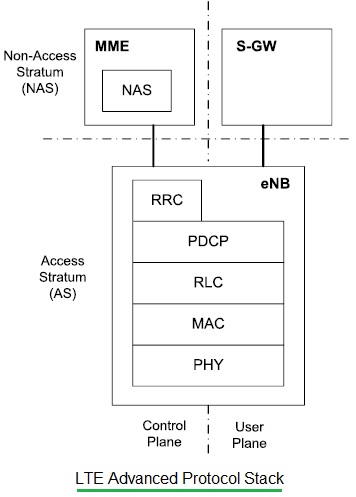LTE Advanced Architecture | LTE Advanced Protocol Stack
This page coversLTE Advanced Architectureand LTE Advanced Protocol Stack.It mentions LTE Advanced architecture for E-UTRAN.LTE Advanced protocol stackconsists of user plane and control plane for AS and NAS.
LTE Advanced Architecture-P-GW, S-GW, MME, S1-MME, eNB, HeNB, HeNB-GW, Relay Node

The figure-1 depicts LTE Advanced (LTE-A) Architecture for E-UTRAN. It consists of P-GW, S-GW, MME, S1-MME, eNB, HeNB, HeNB-GW and Relay Node etc. Following are the functions of these architecture entities.
•P-GW:它代表生产网关。它与S -界面上的GW using S5 interface and with operator's IP services using SGi interface. It has connectivity with PCRP using Gx interface. It connects UE to packet data networks. P-GW assigns IP address to the UE. One UE can have connectivity with more than one PGWs in order to have access to multiple PDNs. It takes care of packet filtering, policy enforcement and charging related services. Moreover it fulfils connectivity between 3GPP (LTE, LTE-A) and non 3GPP (WiMAX, CDMA etc.) technologies.
•S-GW: It stands for Serving Gateway. It interfaces with MME using S11 interface and with SGSN using S4 interface. It connects with PDN-GW using S5 interface as mentioned above. EPC gets terminated at this node/entity. It is connected with E-UTRAN via S1-U interface. Each UE in LTE-A is associated to unique S-GW which has several functions. It helps in inter-eNB handover as well as inter-3GPP mobility. It helps in inter-operator charging. It does packet routing and packet forwarding.
•MME: It stands for Mobility Management Entity. It is major control plane element in LTE advanced architecture. It takes care of authentication, authorization and NAS signaling related security functions. It takes care of selecting either S-GW or PDN-GW or P-GW.
•S1-MME: It provides connectivity between EPC and eNBs.
•eNB: It is main building block or system in LTE-A. It provides interface with UEs or LTE-A phones. It has similar functionality as base station used in GSM or other cellular systems. Each of the eNBs serve one or several E-UTRAN cells. Interface between two eNBs is known as X2 interface.
•HeNB: It stands for Home eNodeB or Home eNB. It is known as Femtocell. It is used to improve coverage in the indoor region of office or home premises. It can be interfaced directly to EPC or via Gateway. Refer什么是LTE毫微微蜂窝➤吗.
•HeNB-GW: It provides connectivity of HeNB with S-GW and MME. It aggregates all the traffic from number of Home eNBs to core network. It uses S1 interface to connect with HeNBs.
• Relay Node: It is used for improving network performance. Referwhat is LTE Relay➤.
LTE Advanced Protocol Stack-PHY, MAC, RLC, PDCP, RRC, NAS

The figure-2 depicts LTE Advanced protocol stack. It is divided into two main parts viz. NAS (Non-Access Stratum) and AS (Access Stratum). Further it is categorized into control plane and user plane. User plane of eNB consists of PHY, MAC, RLC and PDCP layers. Control plane of eNB consists of these 4 layers and in addition houses RRC layer also.
Following are functions of these LTE Advanced protocol stack layers.
•PHY: This layer takes care of frame formation as per TDD or FDD topology and as per OFDMA structure based on BW/FFT. Moreover it takes care of modulation and coding of different control and traffic channels. It covers scrambling and codeword to layer mapping functionalities. It incorporates reference signals (DMRS/ SRS in the uplink while C-RS/ CSI-RS/ UE-RS in the downlink) which are used for channel estimation and channel equalization.
•MAC-Medium Access Control: It takes care of following functions:
-Multiplexing/demultiplexing of RLC Packet Data Units (PDUs).
-Scheduling information reporting.
-Error correction through Hybrid ARQ (HARQ).
-Local Channel Prioritization.
-Padding.
•RLC-Radio Link Control:
-Error correction through Automatic Repeat reQuest (ARQ).
-Segmentation according to the size of the transport block and re-segmentation in case a retransmission is needed.
-Concatenation of SDUs for the same radio bearer.
-Protocol error detection and recovery.
-In-sequence delivery.
•PDCP-Packet Data Convergence Protocol:
-Header compression.
-In-sequence delivery and retransmission of PDCP Session Data Units (SDUs) for acknowledge mode radio bearers at handover.
-Duplicate detection.
-Ciphering and integrity protection.
•RRC-Radio Resource Control:
-Broadcast system information related to Non-Access Stratum (NAS) and Access Stratum (AS).
-Establishment, maintenance, and release of RRC connection.
-Security functions including key management.
-Mobility functions.
-QoS management functions.
-UE measurement reporting and control of the reporting.
-NAS direct message transfer between UE and NAS.
•NAS-Non Access Stratum:
-Connection/session management between UE and the core network.
-Authentication.
-Registration.
-Bearer context activation/deactivation.
-Location registration management.